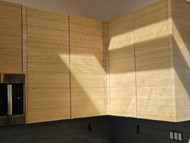5 Benefits of Reconstitued Veneer vs.Natural Wood Veneer
Jul 24th 2025
Reconstituted veneer, also known as engineered veneer, is made from fast-growing plantation woods that are dyed, layered, and compressed to mimic the appearance of natural wood veneer. It offers several advantages over natural wood veneer. Here are five key benefits:
1. Consistency in Appearance
- Reconstituted Veneer:
- Offers uniform grain patterns, textures, and colors across multiple sheets.
- Ideal for projects requiring visual consistency, such as cabinetry, furniture, or paneling.
- Natural Veneer:
- Variability in grain and color is common, even within the same species, which can be a challenge for projects needing a uniform look.
2. Sustainability
- Reconstituted Veneer:
- Made from fast-growing, plantation species like poplar or ayous, reducing the pressure on exotic and endangered wood species.
- Provides an eco-friendly alternative to veneers made from rare or slow-growing hardwoods.
- Natural Veneer:
- Often sourced from mature trees, including rare species, which can contribute to deforestation and environmental degradation.
3. Cost-Effectiveness
- Reconstituted Veneer:
- Generally more affordable than natural veneer from exotic woods because it uses readily available plantation species and streamlined manufacturing processes.
- Lower material waste due to uniformity and fewer defects like knots or splits.
- Natural Veneer:
- Can be significantly more expensive, especially for rare or highly figured woods.
4. Customization and Variety
- Reconstituted Veneer:
- Can replicate the appearance of virtually any wood species, including rare or exotic ones like Macassar Ebony or Walnut Burl, at a fraction of the cost.
- Available in a wider range of colors and designs, including options not found in nature.
- Natural Veneer:
- Limited to the natural grain and color of the wood species, with less flexibility for creative or specific design requirements.
5. Easier Workability
- Reconstituted Veneer:
- Uniform grain and structure make it easier to cut, glue, and finish without concerns about splintering or defects.
- Fewer natural imperfections reduce the need for extensive preparation or patching.
- Natural Veneer:
- Irregularities like knots, varying grain direction, and potential voids can complicate the manufacturing process, requiring more time and skill.
Summary Table:
| Benefit | Reconstituted Veneer | Natural Veneer |
|---|---|---|
| Appearance | Uniform, consistent patterns and colors | Natural variations and unique grains |
| Sustainability | Eco-friendly, uses fast-growing plantation woods | Often from endangered or slow-growing trees |
| Cost | Affordable and efficient production | Can be expensive, especially for rare woods |
| Customization | Can mimic any wood or color | Limited to natural wood species |
| Workability | Easier to handle due to consistent structure | More challenging with natural defects |
Reconstituted veneer is an excellent choice for projects requiring uniformity, affordability, and sustainability, while natural veneer is better suited for projects emphasizing the unique beauty and character of genuine wood.
